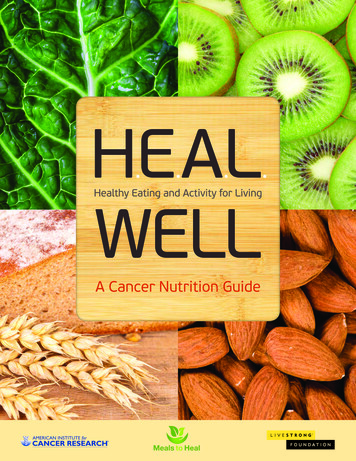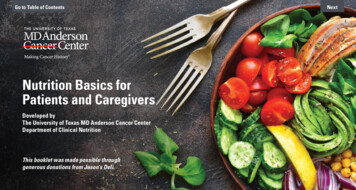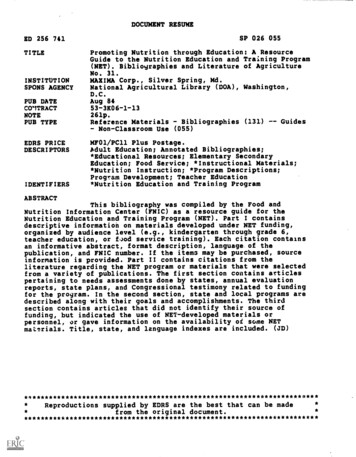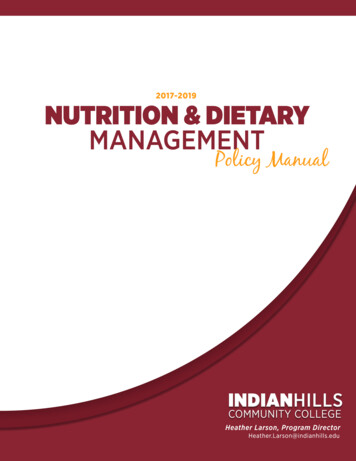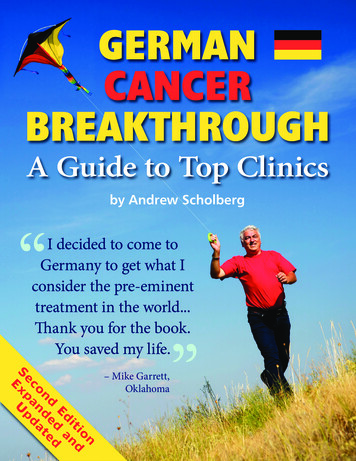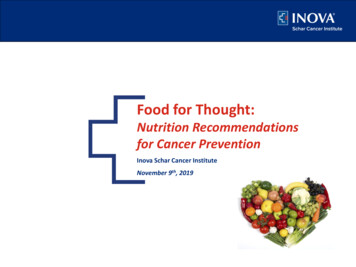
Transcription
Food for Thought:Nutrition Recommendationsfor Cancer PreventionInova Schar Cancer InstituteNovember 9th, 2019
What makes it so hard toknow what to eat?
Objectives Provide evidence based recommendations for diet andexercise to help reduce risk of cancer occurrence andrecurrence Discuss and help clarify common misconceptions inregards to diet and cancer to help alleviate confusion(and stress!) Provide resources for reliable information, recipes, andnutrition counseling
Current RecommendationsWorld Cancer Research Fund/American Institute for Cancer Research. Diet, Nutrition,Physical Activity and Cancer: A Global Perspective. Continuous Update Project ExpertReport 2018.
NutritionIn 2018, World Cancer Research Fund &American Institute for CancerResearch published their 3rd report:“Diet, Nutrition,Physical Activity,and Cancer: aGlobalPerspective”(World Cancer Research Fund/American Institute for CancerResearch, 2018)
1: Be a Healthy WeightKeep your weight within the healthy rangeand avoid weight gain in adult life– Maintain body mass index within normal range: 18.524.9 kg/m 2– Avoid weight gain (measured asbody weight or waist circumference)throughout adulthoodWorld Cancer Research Fund/American Institute for Cancer Research. Diet, Nutrition,Physical Activity and Cancer: A Global Perspective. Continuous Update Project ExpertReport 2018.
1: Be a Healthy Weight
1: Be a Healthy WeightWhy? How does being overweight contribute to cancer risk?
2: Be Physically ActiveBe physically active as part ofeveryday life– Be moderately physically active at least 30minutes/day, 5 days per week– Limit sedentary habitsWorld Cancer Research Fund/American Institute for Cancer Research. Diet, Nutrition,Physical Activity and Cancer: A Global Perspective. Continuous Update Project ExpertReport 2018.
3: Eat a Diet Rich in Wholegrains,Vegetables, Fruit and BeansMake whole grains, vegetables, fruit, and pulses(legumes) such as beans and lentils a major part ofyou usual daily diet– Consume a diet that provides 30 grams/day of fiber from food sources– Include at most meals foods containing whole grains, non-starchyvegetables, fruit and legumesWorld Cancer Research Fund/American Institute for Cancer Research. Diet, Nutrition,Physical Activity and Cancer: A Global Perspective. Continuous Update Project ExpertReport 2018.
3: Eat a Diet Rich in Wholegrains,Vegetables, Fruit and Beans Eat a diet high in all types of plant foods including at least 5servings of non-starchy vegetables and fruit dailyWorld Cancer Research Fund/American Institute for Cancer Research. Diet, Nutrition,Physical Activity and Cancer: A Global Perspective. Continuous Update Project ExpertReport 2018.
3: Eat a Diet Rich in Wholegrains,Vegetables, Fruit and Beans Which fruits and vegetables are the ‘best’ to eat?ALL OF THEM!!!
3: Eat a Diet Rich in Wholegrains,Vegetables, Fruit and Beans I need ideas!!!
3: Eat a Diet Rich in Wholegrains,Vegetables, Fruit and Beans Ideas of ways to increase your ‘plant’ intake:– Check out a local famers market or sign up for a CSA(www.localharvest.com)– Make a goal of trying one different fruit or vegetable per week– Swap common meat portions of a dish for vegetables: Black Bean ‘Burgers’ Buffalo Cauliflower or Cauliflower ‘Steaks’
3: Eat a Diet Rich in Wholegrains,Vegetables, Fruit and BeansHow do plant based diets promote weight loss?High Fiber Content Low Calorie Content SATIETION for LESS CALORIES
NutritionImage credit: American Institute for Cancer Research, www.aicr.org
Plant Based RecipesAmerican Institute for Cancer Research’s Healthy Recipeswww.aicr.org/healthyrecipes
4: Limit Consumption of ‘Fast Foods’ and otherprocessed foodsLimiting these foods helps control calorie intake and maintain ahealthy weight– Limit consumption of processed foods high in fat, starches, orsugars- including ‘fast foods’; many pre-prepared dishes,snacks, bakery foods and desserts; and confectionary (candy)World Cancer Research Fund/American Institute for Cancer Research. Diet, Nutrition,Physical Activity and Cancer: A Global Perspective. Continuous Update Project ExpertReport 2018.
5: Limit Consumption of Red andProcessed MeatEat no more than moderate amounts of red meat,such as beef , pork, and lamb.Eat little (if any) processed meat.– If you eat red meat, limit consumption to no more than 18oz per week– Definition of ‘processed meat’: preserved by smoking, curingor salting, or addition of chemical preservatives (examples:ham, bacon, pastrami, sausages, hot dogs and deli meatsare all considered processed meat).World Cancer Research Fund/American Institute for Cancer Research. Diet, Nutrition,Physical Activity and Cancer: A Global Perspective. Continuous Update Project ExpertReport 2018.
6: Limit Consumption of SugarSweetened DrinksDrink mostly water and unsweetened drinks– Do not consume sugar sweetened beveragesWorld Cancer Research Fund/American Institute for Cancer Research. Diet, Nutrition,Physical Activity and Cancer: A Global Perspective. Continuous Update Project ExpertReport 2018.
Speaking of sugar .does it feed cancer?
7: Limit Alcohol ConsumptionFor cancer prevention, it is best not todrink alcohol If you do choose to consume alcohol, it is recommended toconsume less than 1 drink/day for women, and 2 drinks per day formenWorld Cancer Research Fund/American Institute for Cancer Research. Diet, Nutrition,Physical Activity and Cancer: A Global Perspective. Continuous Update Project ExpertReport 2018.
8: Do Not Use Supplements forCancer PreventionAim to meet nutritional needs throughdiet alone– High dose dietary supplements are notrecommended for cancer preventionWorld Cancer Research Fund/American Institute for Cancer Research. Diet, Nutrition,Physical Activity and Cancer: A Global Perspective. Continuous Update Project ExpertReport 2018.
8: Do Not Use Supplements forCancer Prevention
9: BreastfeedingMothers to breastfeed; children to be breastfed– Aim to breastfeed infants exclusively up to 6 monthsand continue with complementary feeding thereafterWorld Cancer Research Fund/American Institute for Cancer Research. Diet, Nutrition,Physical Activity and Cancer: A Global Perspective. Continuous Update Project ExpertReport 2018.
10: Cancer SurvivorsFollow the recommendations for cancerprevention– If able to do so***, aim to follow the recommendations for diet,healthy weight, and physical activity– All cancer survivors should receive nutritional care from anappropriately trained professionalWorld Cancer Research Fund/American Institute for Cancer Research. Diet, Nutrition,Physical Activity and Cancer: A Global Perspective. Continuous Update Project ExpertReport 2018.
Oncology Dietitians at InovaJenniferAhmed, RD,CNSCCaitlin Benda,MBA, MS, RD,CSOLauren Fay,RD, CSO,CNSCTaylor Horne,RD, CSOAngie Lord, RDKirstenMartinson, RDSara Negron,MS, RD, CSOAppointments can be made through the Inova Life with Cancerwebsite www.lifewithcancer.com or by calling the Inova Life withCancer Connect line: 703-206-5433 (LIFE)
Do these recommendations work? A large prospective population-based cohort studypublished in July 2018 indicates for each AICRrecommendation followed is associated with a 12%reduction of risk for all cancer types.[4]
Additional Thoughts: Diet patternsrather than individual foods These guidelines emphasize a holistic approach to diet, rather thanindividual foods and nutrients“It appears increasingly unlikely that specific foods,nutrients, or other components of foods arethemselves important singular factors in causing orprotecting against cancer”World Cancer Research Fund/American Institute for Cancer Research. Diet, Nutrition, PhysicalActivity and Cancer: A Global Perspective. Continuous Update Project Expert Report2018.
Tools for Weight Management SuccessTools for Weight Loss Success
Cognitive Behavioral Therapy & WeightManagementBehaviorFeelingThoughtSituation
Automatic Thoughts
Sabotaging Thoughts “I worked so hard today, I deservethis.” “I won’t look at the scale.” “I really want to eat or eat moreof .” “I already blew it today, so I’ll just keepeating and begin again tomorrow.” “I’d rather just see how things goinstead of planning.”
“Between stimulus and responseThere is a space.In that space is our powerTo choose our response.In our response lies ourGrowth and our freedom”Viktor Frankl
MindfulnessMindfulness means paying attention in aparticular way:on purposein the present momentnon-judgmentallyJon Kabat-Zinn
Mindful Eating Food selection; appreciate your foodMeal preparationSetting/EnvironmentIntentionEat with others/eat sitting downEat slowly without distractionListen to hunger cuesDistinguish between actual hunger vs. non-hungertriggers for eating Engage your senses by noticing colors, smells, sounds,textures, tastes
Benefits Increase weight loss Helps to recognize emotionsand physical sensations Decrease response toinappropriate cues for eatingsuch as advertising, boredomor anxiety Gain control over eatinghabits(Dalen, 2010)
Cognitive Behavioral Journaling What did I do today to avoid unplanned eating?If I deviated, what happened?What thinking mistakes did I make?What can I learn from this for next time?
Nutrition JournalingTools for Weight Loss Success: Pen & PaperFood Journaling Electronic:– Myfitnesspal– WW (Weight Watchers)– Loseit!
Priority ChartEssential ActivitiesHighly DesirableDesirableWorkWork in gardenTVFood shoppingClothes shoppingManicures(Beck, 2017)
Setting a Weight Goal Short term, small weight loss goals is often a more effective way towork towards achieving a larger weight loss goal– Weight loss between 5-10% is likely to produce health benefits,such as improvements in blood pressure, blood cholesterol, andblood sugar 5-10% of your current body weight is a reasonable weight loss goalto begin with, making incremental changes as your weight lossprogresses(Blackburn, 1995; NIH, 1998; Dittus, 2018)
Other Measurements of WeightLoss Waist Circumference– Abdominal fat is more likely to be visceral fat (rather thansubcutaneous) which can have more negative health consequencesand contribute to chronic inflammation– Recommend weight measurementfor women is 31.5 inches and 37 inches for men
Reliable Nutrition Resources American Institute for Cancer Research:www.aicr.org American Cancer Society:www.cancer.org Academy of Nutrition and Dietetics:www.eatright.org Oncology Dietetics Practice Groupwww.oncologynutrition.orgReputable resources for the latest research, information, pamphlets, andrecommendations regarding nutrition and cancer.
Finding a Registered Dietitian Academy of Nutrition and Dietetics: www.eatright.org– Click on “find an expert”– Search by zip code and specialty
More Questions?Feel free to contact me!Contact: Emily.Biely@inova.org; Lauren.Fay@inova.org;Angela.Lord@inova.org; Sara.Negron@inova.org
Works CitedAziz, Noreen M. “Cancer Survivorship Research: Challenges and Opportunity.” J.Nutr. 132: 3494S-3503S, 2002Beck, J. (2017). The Diet trap solution: Train your brain to lose weight and keep it off for good. HarperOne.Beck, J. S. (2007, 7th Printing 2017). The Beck diet solution: Weight loss workbook. Birmingham, Ala.: Oxmoor House.Blackburn G. (1995). Effect of degree of weight loss on health benefits. Obesity Research 3: 211S-216SDalen, J., Smith, B.W., Shelley, B.M., Sloan, A.L., Begay, D. (2010). Pilot study: Mindful eating and living (MEAL): Weight, eatingbehavior, and psychological outcomes associated with a mindfulness-based intervention for people with obesity. ComplementTher Med, Dec: 18(6), 260-264.Dittus, K. L., Harvey, J. R., Bunn, J. Y., Kokinda, N. D., Wilson, K. M., Priest, J., & Pratley, R. E. (2018). Impact of a behaviorallybased weight loss intervention on parameters of insulin resistance in breast cancer survivors. BMC Cancer, alette C, Adjibade M, Srour B, et al. Cancer-Specific and General Nutritional Scores and Cancer Risk: Results from theProspective NutriNet-Santé Cohort. Cancer Res. 2018;78(15):4427-4435.World Cancer Research Fund/American Institute for Cancer Research. Diet, Nutrition, Physical Activity and Cancer: A GlobalPerspective. Continuous Update Project Expert Report 2018.
Beck, J. (2017). The Diet trap solution: Train your brain to lose weight and keep it off for good. HarperOne. Beck, J. S. (2007, 7th Printing 2017). The Beck diet solution: Weight loss workbook. Birmingham, Ala.: Oxmoor House. Blackburn G. (1995). Effect of degree of weig



